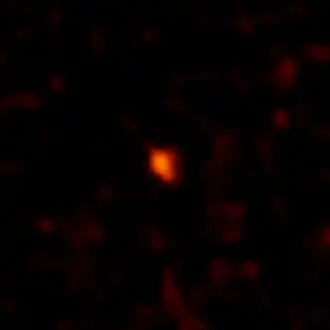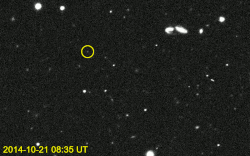2014 UZ224
 2014 UZ224 imaged by ALMA | |
| Discovery[1] | |
|---|---|
| Discovered by | David Gerdes et al. |
| Discovery site | Cerro Tololo Obs. |
| Discovery date | 21 October 2014 |
| Designations | |
| 2014 UZ224 | |
| DeeDee (nickname) | |
| TNO[2] · SDO[3] | |
| Orbital characteristics[2] | |
| Epoch 31 May 2020 (JD 2459000.5) | |
| Uncertainty parameter 5 · 6[1] | |
| Observation arc | 12.08 yr (4,414 days) |
| Earliest precovery date | 15 October 2006[1] |
| Aphelion | 176.988±0.453 AU |
| Perihelion | 38.295±0.029 AU |
| 107.642±0.275 AU | |
| Eccentricity | 0.64423 |
| 1116.81±4.28 yr (407,913 days) | |
| 320.482±0.210° | |
| 0° 0m 3.177s / day | |
| Inclination | 26.790° |
| 130.699±0.004° | |
| ≈ 27 May 2142[4] ±67 days | |
| 29.989±0.063° | |
| Physical characteristics | |
| 635+65 −72 km[3] | |
| 0.131+0.038 −0.028[3] | |
| g–r = 0.77±0.11 r–i = 0.39±0.07 i-z = 0.22±0.16[3] | |
| 23.38±0.05[3] | |
2014 UZ224 is a large trans-Neptunian planetoid orbiting in the scattered disc of the outermost Solar System. As of 2021, it is approximately 89.7 AU (13.42 billion km) from the Sun, and will slowly decrease in distance until it reaches its perihelion of 38 AU in 2142. The discoverers have nicknamed it "DeeDee" for "Distant Dwarf".[5][6]
2014 UZ224 was discovered by a team led by David Gerdes using data collected by the large camera Dark Energy Camera (DECam).[7][8] The discovery was announced by the Minor Planet Center on 11 October 2016.[9] It has a diameter of ~635 km (395 mi) and reflects just 13 percent of the sunlight that hits it.[3][2] The earliest known precovery observations of 2014 UZ224 were taken at the Mauna Kea Observatory on 15 October 2006.[1]
2014 UZ224 has not yet been imaged by high-resolution telescopes, so it has no known moons.[10] The Hubble Space Telescope is planned to image 2014 UZ224 in 2026, which should determine if it has significantly sized moons.[10]
Orbit


It orbits the Sun once every approximately 1,100 years and is the second farthest object from the Sun with a stable orbit. Its perihelion is almost as close as Pluto’s aphelion and will reach it on 22 May 2142.
Numbering and naming
As of 2025, this minor planet has not been numbered or named by the Minor Planet Center.
See also
- List of possible dwarf planets
- 532037 Chiminigagua – large scattered disc object (≈740 km diameter) with a moon, discovered by DECam
- 2017 OF201 – extreme scattered disc object and dwarf planet candidate
- 2021 DR15 – large scattered disc object and dwarf planet candidate
- List of Solar System objects by size
- List of Solar System objects most distant from the Sun
References
- ^ a b c d "2014 UZ224". Minor Planet Center. International Astronomical Union. Retrieved 5 January 2021.
- ^ a b c d "JPL Small-Body Database Browser: (2014 UZ224)" (last observation: 2018-11-15; arc: 4.24 years). Jet Propulsion Laboratory. Retrieved 11 October 2016.
- ^ a b c d e f g Gerdes, D. W.; Sako, M.; Hamilton, S.; Zhang, K.; Khain, T.; Becker, J. C.; et al. (April 2017). "Discovery and Physical Characterization of a Large Scattered Disk Object at 92 AU". The Astrophysical Journal Letters. 839 (1): 7. arXiv:1702.00731. Bibcode:2017ApJ...839L..15G. doi:10.3847/2041-8213/aa64d8. S2CID 35694455.
- ^ JPL Horizons Observer Location: @sun (Perihelion occurs when deldot changes from negative to positive. Uncertainty in time of perihelion is 3-sigma.)
- ^ Scoles, Sarah (18 October 2016). "Soon you won't care about a newly discovered dwarf planet". Wired. ISSN 1059-1028.
- ^ "New dwarf planet solar system's 2nd most distant". University of Michigan News. 14 October 2016. Retrieved 15 August 2025.
- ^ Cofield, Calla (12 October 2016). "New Dwarf Planet Found in Our Solar System". Scientific American. Retrieved 12 October 2016.
- ^ Palca, Joe (11 October 2016). "A Friend for Pluto: Astronomers Find New Dwarf Planet in Our Solar System". NPR.org.
- ^ "MPEC MPEC 2016-T104 : 2014 UZ224". IAU Minor Planet Center. 11 October 2016. Retrieved 11 October 2016. (K14UM4Z)
- ^ a b Proudfoot, Benjamin (August 2025). "A Search For The Moons of Mid-Sized TNOs". Mikulski Archive for Space Telescopes. Space Telescope Science Institute: HST Proposal 18010. Cycle 33. Retrieved 17 August 2025.
External links
- 2014 UZ224 ("DeeDee") Fact Sheet
- 2014 UZ224 at AstDyS-2, Asteroids—Dynamic Site
- 2014 UZ224 at the JPL Small-Body Database
_(cropped).jpg)
